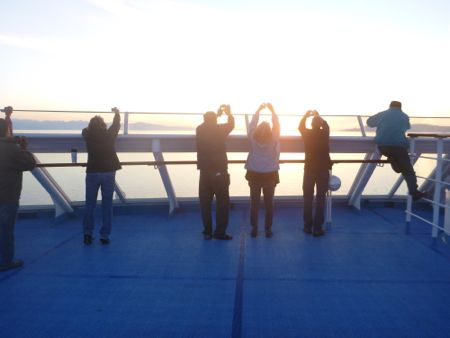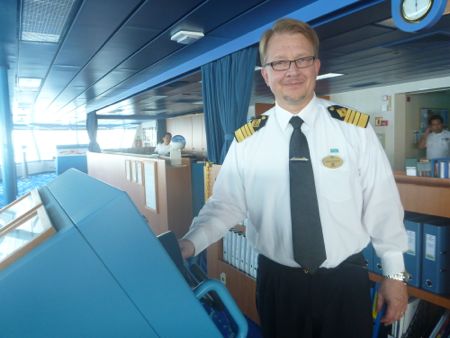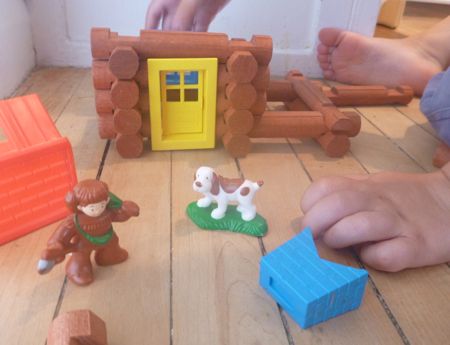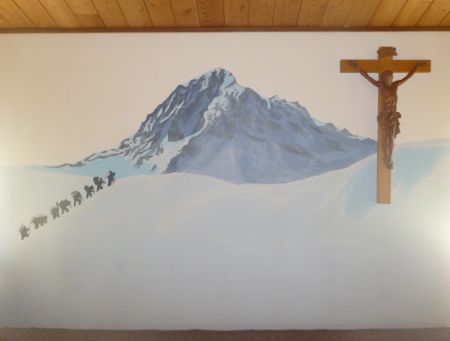Our ship blasts its departure on the horn. The two-year-old and I wave and people lining the quay wave back. Vancouver opens up along the skyline and then shrinks into the distance.
At last, the open sea.
After weeks of glimpsing the ocean between train and bus rides, we're on the grey whales' home turf, entering the last stages of their migration route, sailing towards the Arctic.

In a day or so we'll be in Alaska, for centuries a land of promise and peril. As we stand on the balcony of our luxury cruise ship, the Norwegian Sun, I feel tinge of shame. This is not my idea of roughing it on the wild, untamed Alaskan seas. It's also way above our budget. But I have my lame excuse; the Alaska Marine Highway ferries weren't running when we needed them.
I'm soon swept up in the holiday mood. It seems every second person we meet is here to celebrate their gold or silver wedding anniversary. With few children on board, the two-year-old is a minor celebrity. We totter between restaurant, 'motion of the ocean' infant dance sessions and the swimming pool on the top desk, which sloshes thrillingly when sailing gets rough.
In the evenings, passengers flock outside with their cameras to try and capture the sunset. Orange spills all over the deck, into the swimming pool and into everyone's eyes.

Waking to a view of whale-grey ocean through our balcony door is my idea of heaven. Through my open cabin window, the sound of waves rushes through our nights.
This same sound would have echoed in the ears of explorers, whalers and a stampede of Klondike prospectors who threw themselves headlong into the wilds of Alaska in the 1800s. Great hopes drove them northwards, to face incredible hardship, danger, often death.
The 'last frontier' still draws people in. Our crew is from all over the world: Nepal, the Philippines, India. Pancakes dripping in maple syrup are brought to our table by Ayu, a waitress from Bali. She can't get enough of the two-year-old. Nine months of every year, Ayu leaves her own child to work on the ship. I find myself blessing Skype for softening the blow for her.

Small, dark-grey dorsal fins soon start to break the waters around us. They appear and disappear so quickly I think I'm imagining them. Then white striped bodies surface. It's a pod of Dall's porpoises, the fastest of all dolphins and porpoises, playing around the boat.
A rumor spreads of a whale being spotted and I rush to gather intelligence. I debrief the spotter. It was black, she says. Showed off its white-splattered tail. Breached several times. She demonstrates a leaping whale with a swoop of her arm. My heart sinks in disappointment. It was a humpback, not a grey.
Up on the bridge, I find the captain, Tommy Stensrud, who started his career on a submarine. He gets continuous whale reports, alerting him to any sightings.

Ships move fast in this area because the whales are speedy too. On the opposite side of the U.S., he says, the East Coast near Boston, there are speed limits to prevent boats bumping into the slower-moving right whales.
Captain Stensrud can't tell me if he sees greys, he doesn't identify species. I realize we've different agendas. I'm looking for whales and he's avoiding them, and anything else large that would damage the ship if they collided. Can't really argue with that. Bummer.
Seeking consolation, I turn to the staff on the excursions desk. They book me on a whale-watch with promised sightings of killer whales and humpbacks, though they've not heard greys mentioned at all.
When the two-year-old is asleep that night I revisit my field guide to the grey whale, searching for clues. That gentle curve of the mouth. The wise, dinosaur eye. It feels like I'm looking for unicorns.
The next day we arrive at our first port of call, Ketchikan. The city was established first as a fishing camp and is known as the salmon capital of the world. In a thrift store, the two-year-old clamours for a log cabin construction set, and gets it.
I explain to him that people here can make houses out of trees. This rustic and simple design has stood the test of time, all the way since the first settlers. He particularly likes the axe-wielding frontiersman and the faithful plastic hound.
On the way back to the ship someone asks me for directions because I 'look Ketchikanian'. I'm chuffed but wonder if it's more about being on my own and rather more loaded down with toddler accessories than the typical tourist.

It's not until we get to Juneau, Alaska's state capital, that I get my whale-watching fix. About twenty of us get into a small boat. Our guide Emily is of Tlingit heritage. Tlingit translates as 'people of the tides'. They've co-habited with the whales since time immemorial.
Emily's slightly ethereal way of flinging herself about the boat makes me think of a mermaid. She shares her knowledge of the whales with a contagious ecstasy. The two-year-old listens intently, 'Is she talking about the humpback whale?' I'm delighted that my little scientist is taking so much in.
The bay is teeming with humpback and killer whales. These 'resident' orcas eat fish and live peacefully alongside other whales; very different from the 'transients' that attack grey whale calves back in the deep waters of Monterey.
Humpbacks sizes of buses frolic close by. The two-year-old spots a mother and baby orca jumping together, splashing silver from their black and white uniforms. Beautiful.
Then, an adult orca comes straight for the boat.
The huge, black dorsal fin cuts silently through the water towards us. It's chest height. Gripping the rail, I freeze in primeval horror as the head breaks the surface a few meters away. I imagine the helplessness of a grey whale calf. At the last second it dives under the boat and is gone.
They ship's next stop is Skagway, meaning beautiful woman in the Tlingit language. Locals soon tell me this gorgeous town is where Sarah Palin lived as a young child. But it has an altogether more intriguing tale to tell. It's full of the ghosts of the gold rush.
When gold was found in the Klondike, Skagway exploded. Thousands of prospectors arrived by sea. Many died making the journey over the mountains at White Pass. A picture in the church shows a trail of tiny people struggling up through the snow.

At the local library a copy of the Skaguay News dated Dec. 31, 1897 grabs my attention. There's a stern practical guide for women taking the perilous journey north. It catapults me into the past.
'Women have made up their minds to go to the Klondike', I read, captivated, 'so there is no use trying to discourage them "For when a woman will, she will and you may depend on it."
The writer, Annie Hall Strong, warns, 'Delicate women have no right attempting the trip; it means utter collapse.' For the hardy, she gives a list of essentials to take.
- 1 good dress.
- 1 suit heavy mackinaw, waist and bloomers.
- 1 summer suit, waist and bloomers.
- 3 short skirts of heavy duck or denim to wear over bloomers.
- 3 suits winter underwear.
- 2 pair Arctic mittens.
- 1 pair house slippers.
- 1 pair heavy soled walking shoes.
- 1 pair felt boots.
- 1 pair German socks.
- 1 pair heavy gum boots.
- 1 pair ice creepers.
- 3 pair heavy all-wool stockings.
- 3 pair summer stockings.
- 1 hat with brim broad enough to hold the mosquito netting away from the face...
The list goes on.
I allow myself to indulge in self-aggrandising for a moment. I too am an intrepid, pioneering woman at the gateway to the Klondike. Then I remember my Gore-Tex and the cruise ship, and those people struggling up the mountain path. And I swear I'll never complain, about anything, ever, again.
Not even about the fact that I haven't seen a grey whale since Baja. Next stop Barrow, an Arctic city right at the top of the U.S.
Greys, you better be there.